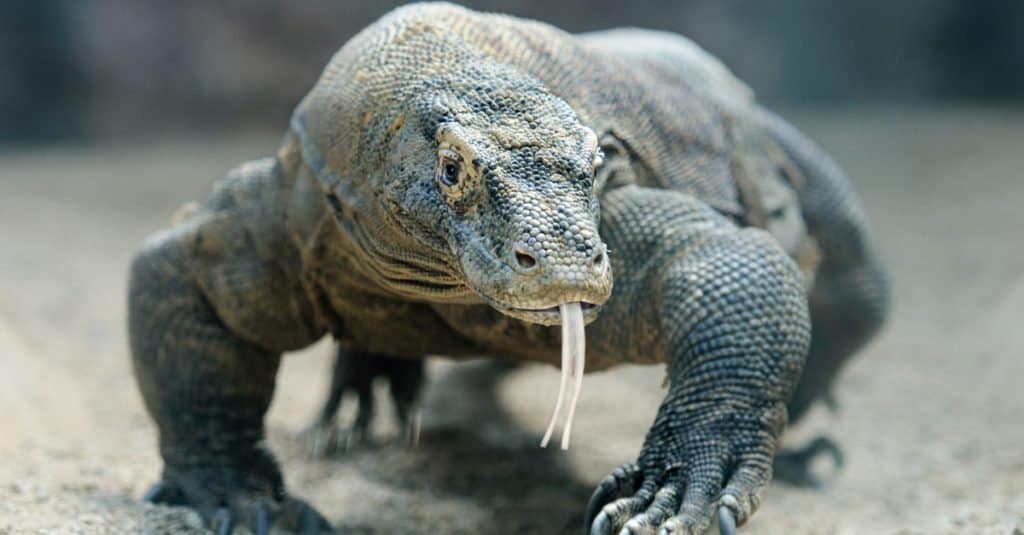Komodo dragons are the largest lizards on earth and one of the most dangerous. These massive, 200-300 pound reptiles are known for their deadly venom, which they use to kill their prey. So, when a bat decided to taunt a Komodo dragon by dangling from a tree branch just out of reach, it probably should have known better. Watch the video below to see a bat taunt a Komodo dragon and instantly regret it.
Check Out The Entire Video Below!
Komodo Dragon, 1 – Bat, Zero
In this video, you see a bat hanging from a tree, seemingly taunting the Komodo dragon below. At first, the Komodo dragon’s attempts to catch the bat are unsuccessful. But it keeps trying and, after several attempts, grabs the bat in its powerful jaws, devouring it whole. The incident was caught on camera and posted on YouTube for public viewing. It’s both fantastic and horrific to watch, but one thing is for sure, you just can’t look away!
The video starts with an up-close view of the Komodo dragon’s fierce face. The point of view then changes to the dragon surrounded by trees. As soon as the Komodo dragon sees a bat hanging in a nearby tree, it’s clear that the dragon feels like a snack. Slowly, the reptile begins to stalk its prey, methodically making its way closer and closer to the tree where the bat is hanging. However, the bat seems oblivious to the danger, continuing to hang upside down, grooming itself.
Different Tactic, Different Outcome

The Komodo Dragon is a large species of lizard that is only found on a handful of islands in the Indonesian archipelago.
©iStock.com/photomaru
But the Komodo dragon is relentless and finally reaches the tree. It tries to climb up, but the bat is just out of reach. So, the Komodo dragon does something unexpected: it opens its mouth and hisses at the bat. Again and again, the Komodo dragon tries to climb the tree. Finally, it reaches up on its back legs, snapping with its powerful jaws, hoping to either dislodge the bat or snatch it up in its mouth. But the bat just hangs there, seemingly unafraid. It almost seems to taunt the lizard in its futile attempts.
Persistence Wins the Prize
Finally, the Komodo dragon loses its patience. It opens its mouth wide and lunges at the bat, clamping down on it with its razor-sharp teeth. The bat finally realizes the danger it’s in and begins to flap its wings as if to get away. But it’s too late. The Komodo dragon lunges forward and catches the bat in its mouth. The bat tries to fight back, but the Komodo dragon is too strong. The bat struggles futilely as the dragon bites down. The lizard squeezes tighter and tighter, thrashing its head from side to side, mauling and ripping the bat apart until its struggles stop altogether.
Moral of the Story? Don’t Taunt a Komodo Dragon
But the Komodo dragon doesn’t stop there. It swallows the bat whole; bones, wings, and all. You can see the wings and little feet of the bat poking out of the Komodo dragon’s mouth as it gulps it down. And then it’s gone, leaving nothing behind to show that the bat ever existed.
It’s a brutal and gruesome sight, but it’s also a fascinating look into the hunting habits of one of the most feared predators on the planet. The Komodo dragon is a fascinating and dangerous creature, and this video reminds us just how deadly they are. So if you’re ever lucky (or unlucky) enough to see one in person, be sure to give them a wide berth.
Is It Normal for Komodo Dragons to Eat Bats?
Komodo Dragons are known to be solitary hunters, often stalking and ambushing their prey. They typically feed on other lizards, snakes, birds, fish, and small mammals. When they have the opportunity, they will catch larger animals like wild pigs and goats. However, they have also been known to consume bats along with other smaller animals like insects and carrion (dead animal carcasses). Komodo dragons will even sometimes scavenge for food if necessary. Their diet is highly varied depending on the availability of food in their environment. They will eat just about anything that crosses their path!
Is This Normal Bat Behavior?
Not really, no. Although bats typically don’t show aggression, they are not particularly friendly either. This is because of their natural wariness of large animals that could potentially be predators. As a result, these creatures tend to steer clear of people and other animal activities as much as possible. For the most part, bats are content to stay away from others and go about their own business in search of food or shelter.
Bats are very friendly with each other, though! Bats have been found to roost together in large colonies, and some species of bats form lifelong monogamous bonds. They are known to engage in complex behaviors such as collective food searching and group thermoregulation. Bats also demonstrate high levels of communication through vocalizations, body language, and the use of chemical signals. In addition to these social behaviors, bats can recognize individual members of their own species based on facial recognition cues. Interestingly, some bat species will even use cooperative parenting techniques or share grooming tasks with other individuals within their colony! This shows that although many people think of them as solitary creatures, bats are actually quite social animals!
The photo featured at the top of this post is © iStock.com/kiwisoul
Thank you for reading! Have some feedback for us? Contact the AZ Animals editorial team.






